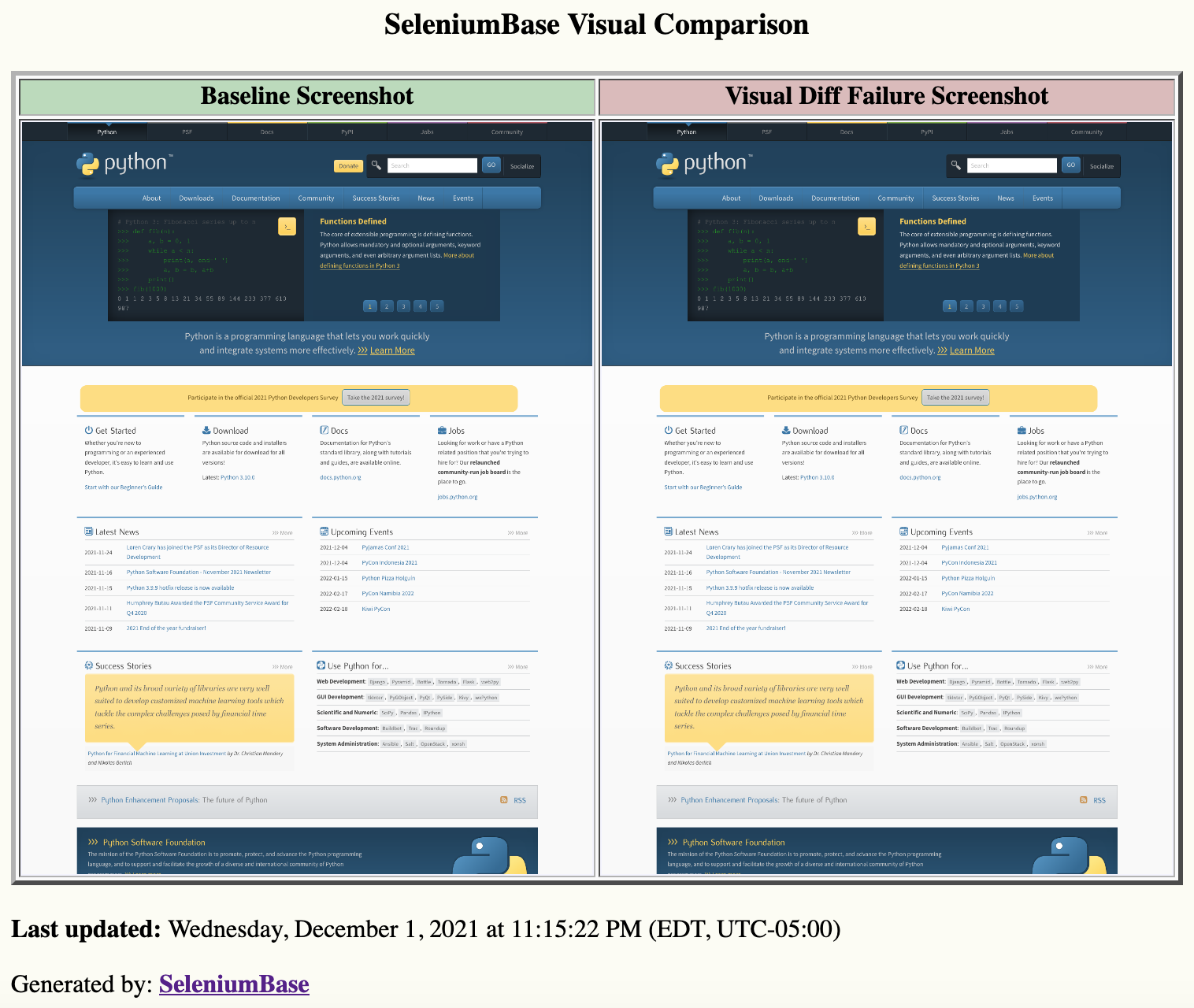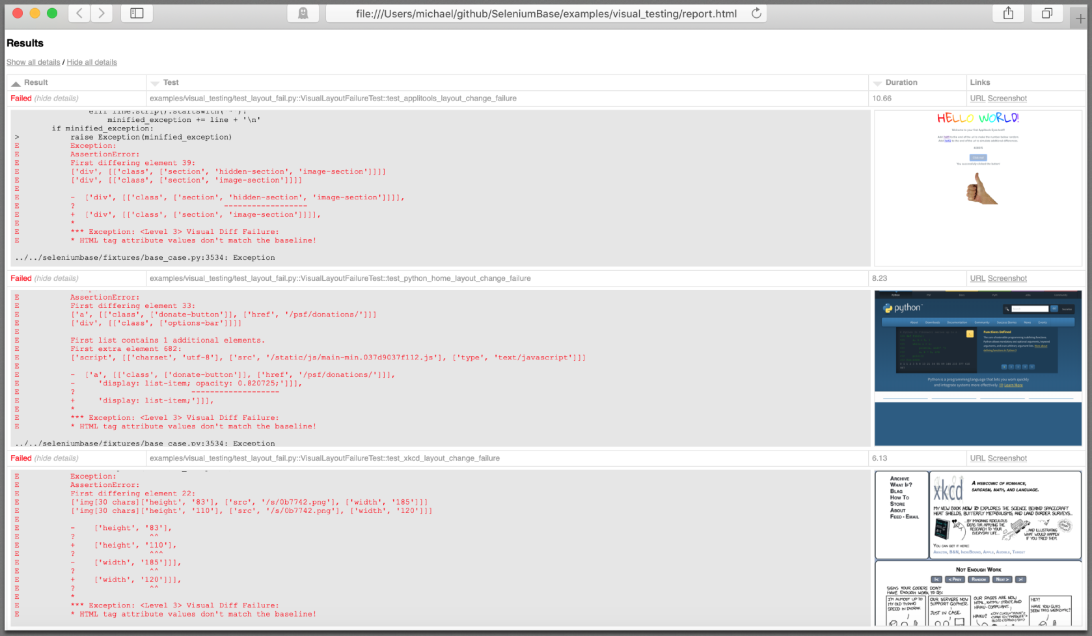|
|
||
|---|---|---|
| .. | ||
| case_plans | ||
| ReadMe.md | ||
| __init__.py | ||
| layout_test.py | ||
| python_home_test.py | ||
| test_layout_fail.py | ||
| xkcd_visual_test.py | ||
ReadMe.md
 Automated Visual Regression Testing
Automated Visual Regression Testing
Automated Visual Regression Testing can help you detect when the layout of a web page has changed. Instead of comparing pixels from screenshots, layout differences can be detected by comparing HTML tags and attributes with a baseline. If a change is detected, it could mean that something broke, the web page was redesigned, or dynamic content changed.

(Watch the tutorial on YouTube)
To handle automated visual testing, SeleniumBase uses the self.check_window() method, which can set visual baselines for comparison and then compare the latest versions of web pages to the existing baseline.
The first time a test calls self.check_window() with a unique name parameter, the visual baseline is set, which means a folder is created with the following files:
After the first time self.check_window() is called, later calls will compare the HTML tags and attributes of the latest window to the ones from the first call (or to the ones from the call when the baseline was last reset). Additionally, a latest.png screenshot is saved in the same folder, which can help you determine if/when the existing baseline needs to be reset.
Here's an example call:
self.check_window(name="first_test)", level=3)
On the first run (or if the baseline is being set/reset) the "level" doesn't matter because that's only used for comparing the current layout to the existing baseline.
Here's how the level system works:
As shown, Level-3 is the most strict, Level-1 is the least strict. If the comparisons from the latest window to the existing baseline don't match, the current test will fail, except for Level-0 checks, which print Level-3 results without failing the test.
You can reset the visual baseline on the command line by adding the following parameter at runtime:
--visual_baseline
As long as --visual_baseline is used on the command line while running tests, the self.check_window() method cannot fail because it will rebuild the visual baseline rather than comparing the html tags of the latest run to the existing baseline. If there are any expected layout changes to a website that you're testing, you'll need to reset the baseline to prevent unnecessary failures.
self.check_window() will fail with "Page Domain Mismatch Failure" if the domain of the current URL doesn't match the domain of the baseline URL.
If you want to use self.check_window() to compare a web page to a later version of itself in the same test, add the baseline=True parameter to your first self.check_window() call to use that as the baseline. (This only makes sense if you're calling self.check_window() more than once with the same "name" parameter in the same test.)
Automated Visual Testing with self.check_window() is not very effective for websites that have dynamic content because that changes the layout and structure of web pages. For those pages, you're much better off using regular SeleniumBase functional testing, unless you can remove the dynamic content before performing the comparison, (such as by using self.ad_block() to remove dynamic ad content on a web page).
Example usage of self.check_window() with different levels:
self.check_window(name="testing", level=0)
self.check_window(name="xkcd_home", level=1)
self.check_window(name="github_page", level=2)
self.check_window(name="wikipedia_page", level=3)
self.check_window(name="helloworld", baseline=True)
### Do something that may change the web page
self.check_window(name="helloworld", level=3)
Here's an example where clicking a button makes a hidden element visible:
from seleniumbase import BaseCase
BaseCase.main(__name__, __file__)
class VisualLayoutTest(BaseCase):
def test_applitools_layout_change_failure(self):
self.open('https://applitools.com/helloworld?diff1')
print('\nCreating baseline in "visual_baseline" folder.')
self.check_window(name="helloworld", baseline=True)
# Click a button that changes the text of an element
self.click('a[href="?diff1"]')
# Click a button that makes a hidden element visible
self.click("button")
self.check_window(name="helloworld", level=3)
Here's the output of that: (Text changes do not impact visual comparisons)
AssertionError:
First differing element 39:
['div', [['class', ['section', 'hidden-section', 'image-section']]]]
['div', [['class', ['section', 'image-section']]]]
- ['div', [['class', ['section', 'hidden-section', 'image-section']]]],
? ------------------
+ ['div', [['class', ['section', 'image-section']]]],
*
*** Exception: <Level 3> Visual Diff Failure:
* HTML tag attribute values don't match the baseline!
Here's an example where a button is removed from a web page:
from seleniumbase import BaseCase
BaseCase.main(__name__, __file__)
class VisualLayoutTest(BaseCase):
def test_python_home_layout_change_failure(self):
self.open('https://python.org/')
print('\nCreating baseline in "visual_baseline" folder.')
self.check_window(name="python_home", baseline=True)
# Remove the "Donate" button
self.remove_element('a.donate-button')
self.check_window(name="python_home", level=3)
Here's the output of that:
AssertionError:
First differing element 33:
['a', [['class', ['donate-button']], ['href', '/psf/donations/']]]
['div', [['class', ['options-bar']]]]
- ['a', [['class', ['donate-button']], ['href', '/psf/donations/']]],
- 'display: list-item; opacity: 0.995722;']]],
? -------------------
+ 'display: list-item;']]],
*
*** Exception: <Level 3> Visual Diff Failure:
* HTML tag attribute values don't match the baseline!
Here's the side_by_side.html file for that, (from the ./latest_logs/ folder), which shows a visual comparison of the two screenshots as a result of the missing "Donate" button:

Here's another example, where a web site logo is resized:
from seleniumbase import BaseCase
BaseCase.main(__name__, __file__)
class VisualLayoutTest(BaseCase):
def test_xkcd_layout_change_failure(self):
self.open('https://xkcd.com/554/')
print('\nCreating baseline in "visual_baseline" folder.')
self.check_window(name="xkcd_554", baseline=True)
# Change height: (83 -> 130) , Change width: (185 -> 120)
self.set_attribute('[alt="xkcd.com logo"]', "height", "130")
self.set_attribute('[alt="xkcd.com logo"]', "width", "120")
self.check_window(name="xkcd_554", level=3)
Here's the output of that:
AssertionError:
First differing element 22:
['img[30 chars]['height', '83'], ['src', '/s/0b7742.png'], ['width', '185']]]
['img[30 chars]['height', '130'], ['src', '/s/0b7742.png'], ['width', '120']]]
- ['height', '83'],
? ^
+ ['height', '130'],
? ^ +
- ['width', '185']]],
? ^^
+ ['width', '120']]],
? ^^
*
*** Exception: <Level 3> Visual Diff Failure:
* HTML tag attribute values don't match the baseline!
To run the example (from examples/visual_testing/) with a pytest HTML Report, use:
pytest test_layout_fail.py --html=report.html
Here's what the pytest HTML Report looks like:

In conclusion, open source automated visual testing tools are being built directly into test frameworks, and this trend is growing. Just like many years ago when free Wi-Fi at coffee shops replaced Internet cafes that charged money for Internet access, open source tools for visual testing will replace their paid counterparts in time. You'll remember this next time you're sipping your Starbucks® Pumpkin Spice Latte with your free Internet access, instead of paying for Internet at cybercafes.
